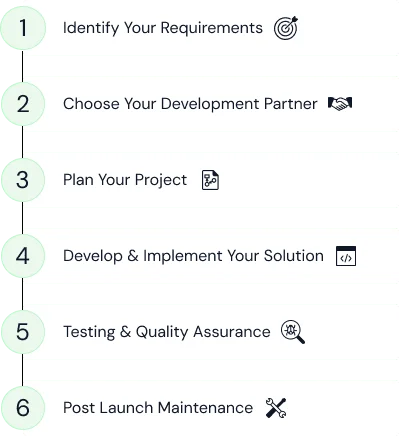Introduction
Just like any complex undertaking, custom software development of any kind can seem like an overwhelming project. But in reality, planning, creating, and implementing a new application is a multistep process, with success in each step reliant on the success of the step before.
When we take it one phase at a time, the prospect becomes more manageable. If your business is ready for bespoke software to support your growth goals, here is the bulletproof six-step framework for getting it right…

1. Identify your requirements
You've probably got a vision in mind for what your software solution will help you achieve, but what exactly do you need it to do? This is the first step in custom software development.
Thoroughly and methodically work through your existing processes, needs, and gaps, and make a list of the features and requirements you need from a software solution. This will help you have productive conversations with potential development partners about everything from technical details to timelines — and, of course, costs.
2. Choose your development partner
There are countless software vendors on the market today, so how do you decide which one is right for you? We go into more detail in our article about how to choose a custom software development company, but these are the highlights:
The right software developer understands your business objectives and has the technical expertise to back it up. They're eager to collaborate with you to truly solve your problems, not just to build you a shiny, trendy platform and collect their payment.
They have a ‘success mindset’, they can talk business as well as they can talk tech, and they have the processes in place to keep everyone, on your team and theirs, on the same page from beginning to end.
We recommend you interview several vendors, and don't be afraid to ask hard questions when you do. The right partner can make a big difference in the success or failure of your software.

3. Plan your project
Once you choose your vendor, the next step is about planning. A thorough discovery process will allow stakeholders and your development team to sit down and work through every aspect of the project, from both a business and a technical standpoint.
At this stage, you'll hone your list of requirements, and your developer may even put together some prototypes to model functionality and user experience. Though we know you're excited to start building the project, don't skimp on the discovery phase. And don't let your vendor try to skimp, either.
In custom software development, the old adage of “prior preparation prevents poor performance” rings especially true!
4. Develop and implement your solution
The next step is the actual work of developing the project using the selected programming language and technology stacks.
Often, development is carried out simultaneously with testing (step 5), which allows the vendor to analyze the work being done and implement corrections where needed before delivery. At this stage, it's important that all stakeholders collaborate closely. The coordination among software engineers, quality assurance engineers, and design engineers directly affects the quality of the entire project.
Once development is complete (along with testing and quality assurance), it's time to deploy the software. This often happens in three stages: initial data upload, progressive feedback gathering, and full roll-out.
The reasoning behind this step-by-step deployment approach is that launch generally runs alongside additional bug fixes, and it's better for everyone if the developers can gradually detect and fix any possible issues before the software is fully launched.
5. Testing and quality assurance
Quality assurance (QA), or the testing and debugging process, is every bit as important as the development. Conducting testing simultaneously with coding allows the QA team to find and fix bugs before they're so deeply embedded in the project that fixing them requires undoing (and then redoing) days, weeks, or even months of work.
QA should comprise at least 30 percent of the total time allocated for the project, and it's most effective when completed by a separate team, which allows for more objectivity and efficiency.
6. Post-launch maintenance
Deployment shouldn't be the end of your relationship with your custom software vendor. Rather, they should be available in some capacity to support any post-launch needs, from bug fixes to new features that may crop up as the product is used in real-life scenarios.
Even broken down into these bite-sized steps, custom software creation is still a hefty undertaking. Fortunately, no business has to go it alone.
If you're looking for a trusted partner to drive your next custom software development project forward, contact Syberry and tell us about your business goals.



